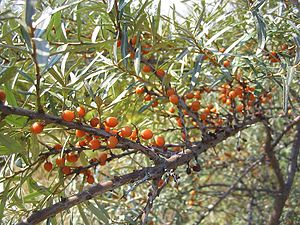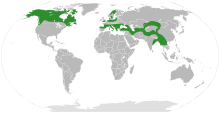Oleaceae
| Oleaceae | ||||||||||||
|---|---|---|---|---|---|---|---|---|---|---|---|---|

Sea buckthorn ( Hippophae rhamnoides ) |
||||||||||||
| Systematics | ||||||||||||
|
||||||||||||
| Scientific name | ||||||||||||
| Elaeagnaceae | ||||||||||||
| Yuss. |
The family of the oleaginous plants (Elaeagnaceae) belongs to the order of the rose-like (Rosales) within the flowering plants (Magnoliopsida). This small family contains only three genera with around 50 to 100 species. It is common in the northern hemisphere and as far as eastern Australia .
They are mostly thorny and drought-resistant shrubs . The most important representative in Central Europe is the sea buckthorn ( Hippophae rhamnoides ). Many species are used by humans.
description


Most species have root nodules with symbiotic , nitrogen-fixing bacteria of the genus Frankia within the Actinomycetales ( actinorrhiza ).
Habit and leaves
They are evergreen or deciduous, small trees or shrubs ; some species are "rod plants". Some species are armed with thorns. Often they are xerophytes .
The leaves are usually alternate and spiral, rarely opposite or seemingly whirling on the branches. There are almost always petioles; they can be short. The simple leaf blade is pinnate and often leathery with a more or less smooth leaf margin. At least on the underside of the leaf blade there are silvery to brownish, shield-shaped covering and / or star hairs, which means that the leaves often appear silvery. Stipules are missing.
Inflorescences and flowers
The flowers stand together individually or in bunches, short, often racemose or spike-like inflorescences . The flowers are hermaphroditic or unisexual. If the flowers are unisexual then the species are usually dioeciously separated ( diocesan ).
The radial symmetry flowers are often fourfold and often scented. A relatively long hypanthium is present. The mostly four (two to eight), petaloid sepals are fused, the calyx teeth being significantly longer than the calyx tube; their colors range from white to cream to yellow. Petals are missing. There are usually four or eight, rarely two or twelve fertile stamens . The very short stamens are free with each other but fused with the sepals. There are no staminodes in female flowers and no rudimentary pistils in the male. There is only one middle carpel with only one anatropic ovule . The carpel is tightly enveloped by the hypanthium, but is free and looks as if it were subordinate. The long stylus ends in an elongated capitate to scar . Pollination occurs by insects ( entomophilia ) and by wind ( anemophilia ).
Fruits and seeds
A fruit is formed per flower, which is enveloped by the base of the flower cup that becomes fleshy when the fruit is ripe (a false fruit ) and acts like a berry or stone fruit and contains a single seed. The ripe fruits, which are often intensely colored, are eaten by birds and the seeds are excreted undigested. Some species are known to dry out their fruits over winter and to be washed away in rivers.
Ingredients and sets of chromosomes
There are calcium oxalate embedded crystals. The fruits contain tannins and mostly vitamin C. Mostly alkaloids occur. If pro anthocyanidins are present, it is cyanidin and delphinidin . Ellagic acid was detected in all three genera. Mostly saponins occur.
The chromosome numbers are n = 6, 10, 11, 13.
Systematics and distribution
The surname Elaeagnaceae was published in 1789 under the name Elaeagni by Antoine Laurent de Jussieu in Genera Plantarum , pp. 74-75. The type genus is Elaeagnus L., whose botanical name is composed of the Greek names for olive ( Olea europaea ) and chaste tree ( Vitex agnus-castus ). There are the invalid spellings Eleagnus and Eleagnaceae.
The Elaeagnaceae family has already been placed in the orders Rhamnales, Proteales and Thymelaeales. Today the Elaeagnaceae form a clade with the Dirachmaceae and Rhamnaceae within the order of the Rosales .
Fossil pollen belonging to the Elaeagnaceae family is only known from the Oligocene 22 to 39 million years ago. It appears that the family originated on the northern continent of Laurasia before it broke up.
The total distribution area of the Elaeagnaceae family extends from the temperate latitudes of the northern hemisphere over the tropics to eastern Australia. Two genera with 74 species occur in China, 59 of them only there.
There are three genera in the Elaeagnaceae family with around 50 to 100 species:
- Sea buckthorn ( Hippophae L. , Syn .: Rhamnoides Miller ): The seven or so species are distributed from north-western Europe to eastern Asia. All seven species are also found in China, with the center of biodiversity on the Qinghai-Xizang Plateau, four species are only found in China. Most species thrive in seasonally humid areas. All are dioecious separate sexes ( diocesan ).
- Olive willow ( Elaeagnus L. , Syn .: Oleaster Heister ex Fabricius ): The approximately 45 to 90 species have a wide distribution area, ranging from southern Europe to Asia and North America. In China alone there are 67 species, 55 of them only there. They have hermaphroditic flowers or are single-sexed ( monoecious ).
- Buffaloberries ( Shepherdia Nutt. , Syn .: Lepargyrea Raf. ): The three or so species are common in northern and western North America. All three species are dioecious and separate sexes ( diocesan ) and have opposite leaves.
use
The fruits of many species are edible. Therefore, Elaeagnus and Hippophae species are cultivated in many areas of the world or it is collected from wild plants. They are particularly rich in vitamin C. Some species are used as ornamental plants in parks and gardens. Thanks to the nitrogen-fixing Frankia , they can still thrive in poor soils. This is why some species, especially Elaeagnus angustifolia, are used for recultivation.
swell
- The family of Elaeagnaceae in APWebsite. (Sections Description and Systematics)
- The Elaeagnaceae family at DELTA. (Section description)
- Haining Qin & Michael G. Gilbert: Elaeagnaceae , p. 251 - the same text online as the printed work , In: Wu Zheng-yi, Peter H. Raven & Deyuan Hong (Eds.): Flora of China , Volume 13 - Clusiaceae through Araliaceae , Science Press and Missouri Botanical Garden Press, Beijing and St. Louis, 2007. ISBN 978-1-930723-59-7 (Description section)
- Y. Nasir: Elaeagnaceae in the Flora of Pakistan : Online. (Section description)
Individual evidence
- ^ David R. Benson: Frankia and Elaeagnaceae.
- ↑ David R. Benson: Elaeagnaceae.
- ↑ a b c d Haining Qin & Michael G. Gilbert: Elaeagnaceae , p. 251 - the same text online as the printed work , In: Wu Zheng-yi, Peter H. Raven & Deyuan Hong (eds.): Flora of China , Volume 13 - Clusiaceae through Araliaceae , Science Press and Missouri Botanical Garden Press, Beijing and St. Louis, 2007. ISBN 978-1-930723-59-7
- ↑ Entries on Elaeagnaceae in Plants For A Future . Retrieved July 29, 2013.

